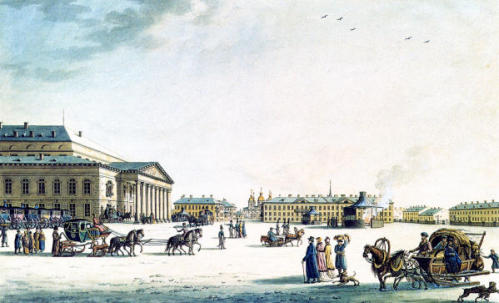Imperial Bolshoi Kamenny Theatre on:
[Wikipedia]
[Google]
[Amazon]

 The Saint Petersburg Imperial Bolshoi Kamenny Theatre (The Big Stone Theatre of Saint Petersburg, russian: Большой Каменный Театр) was a
The Saint Petersburg Imperial Bolshoi Kamenny Theatre (The Big Stone Theatre of Saint Petersburg, russian: Большой Каменный Театр) was a

 The Saint Petersburg Imperial Bolshoi Kamenny Theatre (The Big Stone Theatre of Saint Petersburg, russian: Большой Каменный Театр) was a
The Saint Petersburg Imperial Bolshoi Kamenny Theatre (The Big Stone Theatre of Saint Petersburg, russian: Большой Каменный Театр) was a theatre
Theatre or theater is a collaborative form of performing art that uses live performers, usually actors or actresses, to present the experience of a real or imagined event before a live audience in a specific place, often a stage. The perfor ...
in Saint Petersburg
Saint Petersburg ( rus, links=no, Санкт-Петербург, a=Ru-Sankt Peterburg Leningrad Petrograd Piter.ogg, r=Sankt-Peterburg, p=ˈsankt pʲɪtʲɪrˈburk), formerly known as Petrograd (1914–1924) and later Leningrad (1924–1991), i ...
.
It was built in 1783 to Antonio Rinaldi's Neoclassical design as the Kamenny (i.e., Stone) Theatre; Giovanni Paisiello’s opera ''Il mondo della luna'' was performed at the opening on 24 September. It was rebuilt in 1802 according to the designs of the architect Thomas de Thomon
Thomas may refer to:
People
* List of people with given name Thomas
* Thomas (name)
* Thomas (surname)
* Saint Thomas (disambiguation)
* Thomas Aquinas (1225–1274) Italian Dominican friar, philosopher, and Doctor of the Church
* Thomas the Ap ...
and renamed the Bolshoi, but burned down in 1811. The building was restored in 1818, and modified between 1826 and 1836 by Alberto Cavos to accommodate more modern machinery.
Until 1886, the Bolshoi Kamenny Theatre was principal theatre for both the Imperial Ballet and the Imperial Russian Opera.
In 1886 the building was declared unsafe and, at the behest of the theatre director Ivan Vsevolozhsky, the ballet
Ballet () is a type of performance dance that originated during the Italian Renaissance in the fifteenth century and later developed into a concert dance form in France and Russia. It has since become a widespread and highly technical form ...
and opera
Opera is a form of theatre in which music is a fundamental component and dramatic roles are taken by singers. Such a "work" (the literal translation of the Italian word "opera") is typically a collaboration between a composer and a libr ...
performances moved to the Imperial Mariinsky Theatre, where they have remained ever since. The Imperial Bolshoi Kamenny Theatre was then torn down to make way for the Saint Petersburg Conservatory
The N. A. Rimsky-Korsakov Saint Petersburg State Conservatory (russian: Санкт-Петербургская государственная консерватория имени Н. А. Римского-Корсакова) (formerly known as th ...
.
Notable premieres
Operas * ''A Life for the Tsar
''A Life for the Tsar'' ( rus, "Жизнь за царя", italic=yes, Zhizn za tsarya ) is a "patriotic-heroic tragic opera" in four acts with an epilogue by Mikhail Glinka. During the Soviet era the opera was known under the name ''Ivan Susanin'' ...
'' (1836) – Mikhail Glinka
Mikhail Ivanovich Glinka ( rus, link=no, Михаил Иванович Глинка, Mikhail Ivanovich Glinka., mʲɪxɐˈil ɪˈvanəvʲɪdʑ ˈɡlʲinkə, Ru-Mikhail-Ivanovich-Glinka.ogg; ) was the first Russian composer to gain wide recogni ...
* '' Ruslan and Lyudmila'' (1842) – Mikhail Glinka
* ''La forza del destino
' (; ''The Power of Fate'', often translated ''The Force of Destiny'') is an Italian opera by Giuseppe Verdi. The libretto was written by Francesco Maria Piave based on a Spanish drama, ' (1835), by Ángel de Saavedra, 3rd Duke of Rivas, wi ...
'' (1862) – Giuseppe Verdi
Giuseppe Fortunino Francesco Verdi (; 9 or 10 October 1813 – 27 January 1901) was an Italian composer best known for his operas. He was born near Busseto to a provincial family of moderate means, receiving a musical education with the h ...
Ballets
* '' The Pharaoh's Daughter'' (1862) – chor. Marius Petipa
Marius Ivanovich Petipa (russian: Мариус Иванович Петипа), born Victor Marius Alphonse Petipa (11 March 1818), was a French ballet dancer, pedagogue and choreographer. Petipa is one of the most influential ballet masters an ...
, mus. Cesare Pugni
Cesare Pugni (; russian: Цезарь Пуни, Cezar' Puni; 31 May 1802 in Genoa – ) was an Italian composer of ballet music, a pianist and a violinist. In his early career he composed operas, symphonies, and various other forms of orches ...
* ''The Beauty of Lebanon or The Mountain Spirit
''The Beauty of Lebanon, or The Mountain Spirit'' (french: link=no, La Belle du Liban, ou L'Esprit des montagnes; russian: Ливанская красавица, или Горный дух) is a fantastic ballet in three acts and seven scenes, wi ...
'' chor. by Marius Petipa mus. Cesare Pugni.
* '' The Little Humpbacked Horse'' (1864) – chor. Arthur Saint-Léon
Arthur Saint-Léon (17 September 1821, in Paris – 2 September 1870) was the '' Maître de Ballet'' of St. Petersburg Imperial Ballet from 1859 until 1869 and is famous for creating the choreography of the ballet ''Coppélia''.
Biography
He was ...
, mus. Cesare Pugni
* ''La Bayadère
''La Bayadère'' ("the temple dancer") ( ru. «Баядерка», ''Bayaderka'') is a ballet, originally staged in four acts and seven tableaux by French choreographer Marius Petipa to the music of Ludwig Minkus. The ballet was staged especiall ...
'' (1877) – chor. Marius Petipa, mus. Ludwig Minkus
Ludwig Minkus (russian: link=no, Людвиг Минкус), also known as Léon Fyodorovich Minkus (23 March 1826, Vienna – 7 December 1917, Vienna), was a Jewish-Austrian composer of ballet music, a violin virtuoso and teacher.
Minkus is ...
References
Benois, Alexandre: Reminiscences of the Russian Ballet (London, Wyman & Sons, 1941) {{authority control Opera houses in Russia Music venues completed in 1783 Theatres completed in 1783 1783 establishments in the Russian Empire